Are sailing-yacht owners the smartest owners?
A deep dive into some of the most iconic sailing-yacht projects to see what stimulates billionaires and UHNWIs to invest in them…
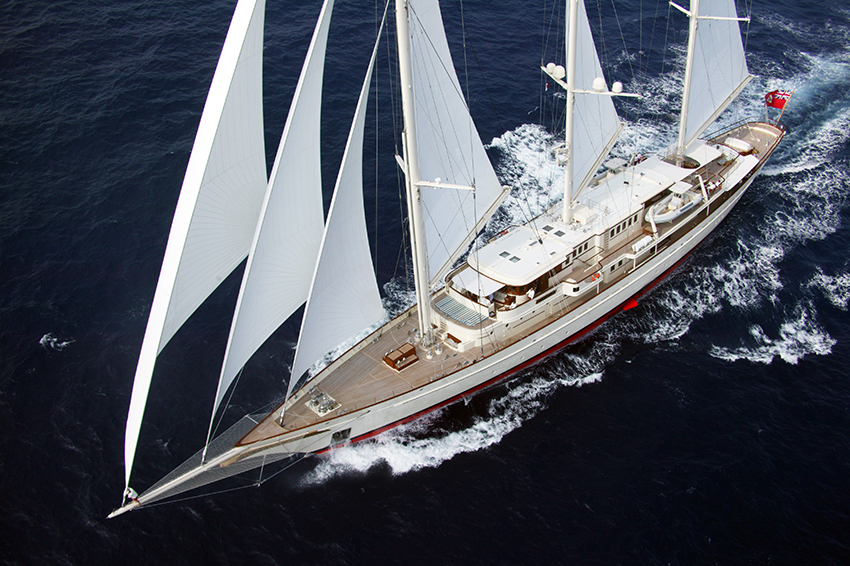
90-metre Athena, owned by Jim Clark. Photo: Franco Page
We recently posed the question on LinkedIn of why are sailing yachts such a small percentage of our market (responses in table below). I suppose I know the answer and we got lots of comments about volume, rig costs and the heeling topic. Some of these comments are integrated into this article, but over the past 36 years, the happiest owners with the best crew relationships seem to have always been on big sailing programmes.
To reinforce the message and to explain the thinking behind this report:
• Sailing is fun
• Sailing is relaxing
• Sailing is energy-efficient
• Sailing is romantic
• Sailing is competitive
• Sailing is majestic
• Sailing is relatively silent
The aim is to put all this into perspective and to perhaps invigorate the sailing market a little because I’m a huge fan of sailing. I raced Fireballs as a boy and enjoyed many a regatta over the decades from New Zealand to St Barths to Newport to Palma to Monaco to Porto Fino to Porto Cervo and other wonderful locations; it was always incredible to be part of this unique community. The spirit and camaraderie seem to replicate itself, no matter where, who, what and when the sailors all get together. Talk of close roundings, near collisions and protests are often balanced with admiration for each other’s yacht – the more beautiful the more the admiration.
In the past few years, when you look at some of the majestic yachts delivered by the custom brands Huisman, Vitters, Perini, Holland Jachtbouw and the primary sailing brands of Swan, Baltic, Wally and Southern Wind, every time a new yacht emerges and steps the mast, there are market ‘oohs’ and ‘aahs’ at the elegance, the balance and the sheer lines or elongated bow. To be honest, I rarely do this when I see a new motoryacht, although there are a few exceptions.
Top six sailing-yacht-builder deliveries, 2010-2024
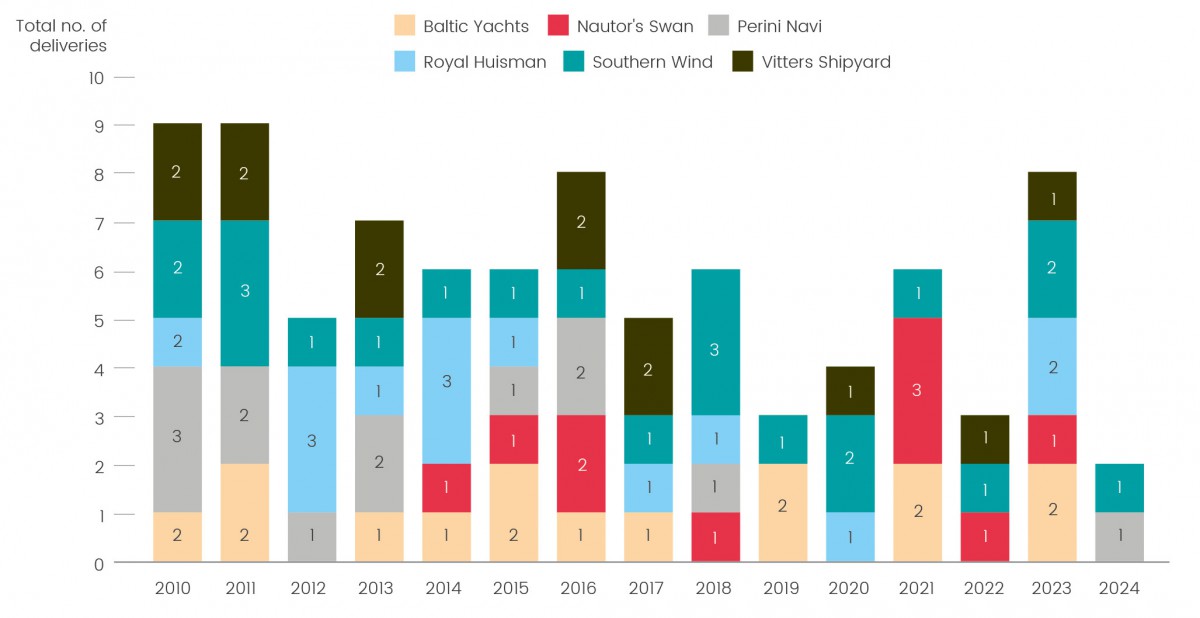
So are the sailing owners the smartest owners? This may sound a little controversial, but there’s something to this when you look at the people behind some of the most impressive and famous sailing yachts over the years. They are best described as ‘legacy projects’, where the yacht name and the owner’s name stick together for the lifespan of the yacht, no matter who owns the yacht in the future. I suppose the late Tom Perkins and Maltese Falcon is the best example of this, no matter who owns the yacht today – it was his vision, confidence and commitment to being brave with the Falcon rig and building an icon.
Tom was an incredibly smart and focused individual who I had the pleasure of sharing the stage with and sailing with on a few occasions. He hated to lose and challenged the market to build something incredible, with a rig system that, once proven, made so much sense for the superyacht category. He was a venture capital (VC) pioneer in Silicon Valley and made big sailing yachts his life and, with reference to our Tech Billionaire article, he exposed big yachts to some pretty incredible people from his financial and tech neighbourhood. Unfortunately, we lost Tom in 2016 and, surprisingly, very few followed his lead with the Falcon rig.
Another super-smart sailing-yacht owner from the same world, who joined Tom Perkins’ VC firm, was the genius Bill Joy, co-founder of Sun Microsystems fame, renowned for writing the Java script (Google it), allegedly over a weekend. I met Bill Joy during a long weekend event he hosted at the Royal Huisman Shipyard, at a brainstorm called a ‘Charrette’, which brought together astronauts, physicists and technologists to push the boundaries of efficiency, hybrid propulsion and future-proof design. The result was S/Y Ethereal, the world’s first hybrid superyacht, delivered in 2009 – a groundbreaking ketch that set new standards in energy management and intelligent system integration. A major refit in 2023 further enhanced its sustainable capabilities, ensuring its pioneering journey continues.
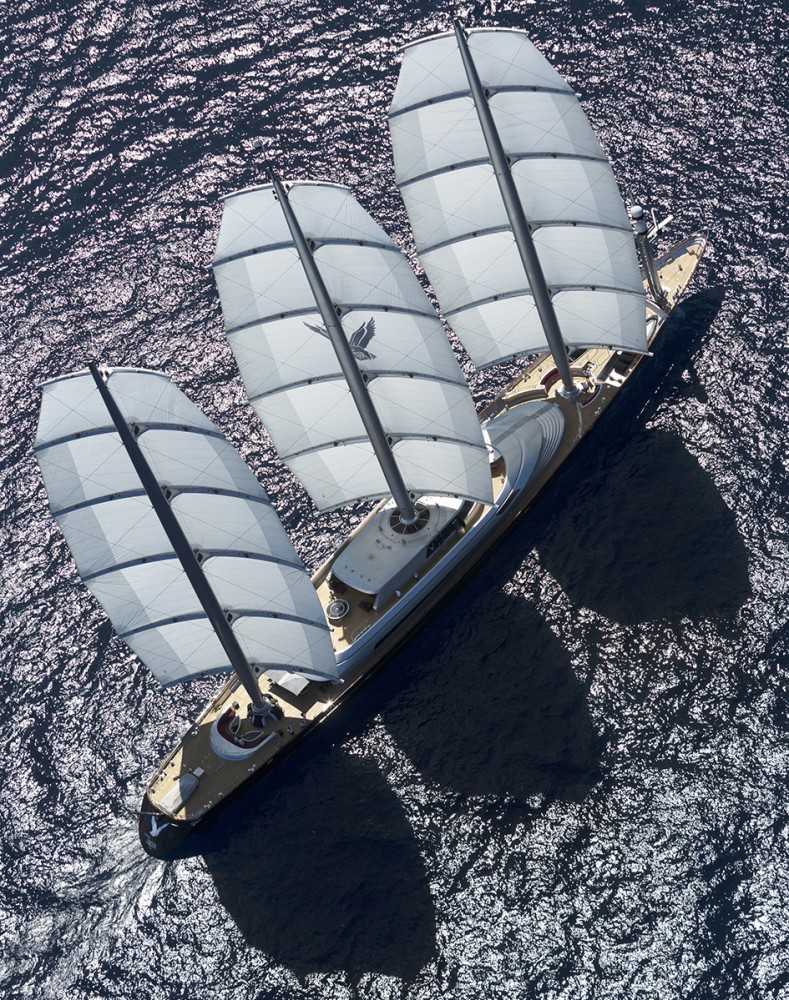
88-metre Maltese Falcon, the legacy project of Tom Perkins.
Another episode in the life of super-sized sailing yachts was shipyard tours with owners. One involved touring the Royal Huisman Shipyard again, viewing S/Y Athena, an elegant three-masted schooner commissioned by Dr Jim Clark, who explained with real passion the ideas, innovations and solutions that he and his team had developed. His fleet also includes the racing machine S/Y Comanche, the J-Class Hanuman and the technologically advanced S/Y Hyperion, all built at Royal Huisman and all of which blazed trails and challenged the market to push boundaries in terms of innovation and performance.
The common theme became clear: these sailing-yacht owners were all extremely bright, wanted to do something different and make a statement, but also loved the idea of racing, sailing, performing and smiling as they crossed the finish line, or enjoying admiring remarks from other owners as to the beauty and elegance of their latest projects.
In addition to Clark, Joy and Perkins, we were introduced to a new potential owner (name withheld) during Covid. He was looking to take a global tour sabbatical on a large sailing yacht, with a very clear plan and budget. As is often the case, having reviewed the market and having explored his options, based on what was available and what he wanted to do, nothing ticked the boxes. An email came through one day, asking what he thought of S/Y Sea Eagle, an 81-metre schooner that was almost triple the planned budget and 30 metres longer than his target asset.
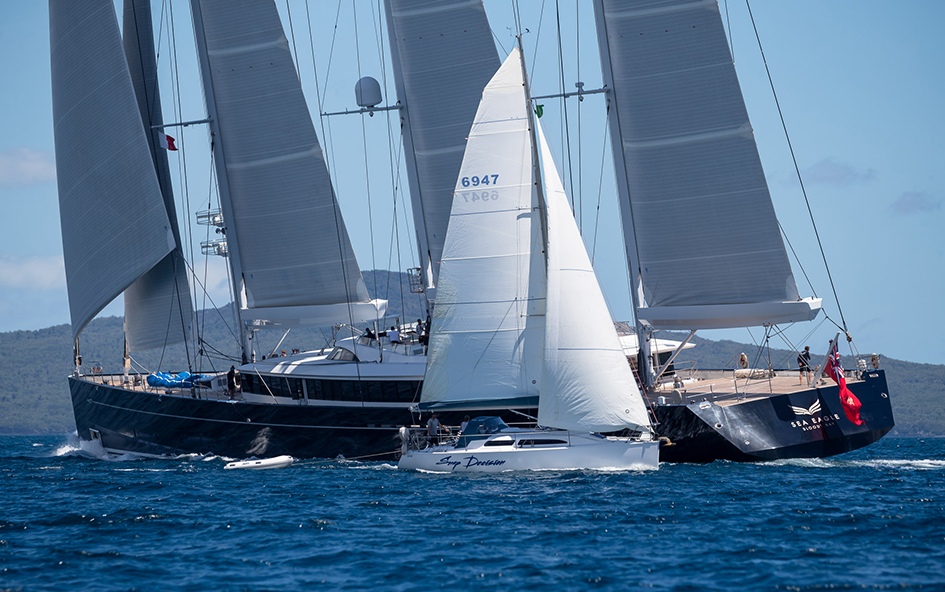
Sea Eagle participating in the New Zealand Millenium Cup. Photo: Jeff Brown
This was a relatively brand-new pedigree build from Royal Huisman, with a high-performance rig configuration, a sleek elongated hull and designed to cover thousands of nautical miles in absolute comfort. The decision was made and the journey of superyacht ownership started with this 80-metre-plus project, considering all the owner’s previous yachts were in the 50 to 80-foot range. Very recently, the proud owner was all smiles in the Southern Hemisphere, having just competed in the Millennium Cup in New Zealand. We plan to catch up with him shortly to get his personal insights into his journey and to find out if his decision was the right one.
It also makes sense to talk about the iconic Oceanco and Vitters-built sailing giant – essentially Maltese Falcon’s big sister – the 106.7-metre S/Y Black Pearl, built for the late Oleg Burlakov, a victim of Covid. This was another passion project, designed, built and engineered to be a market challenger, driven by a super-smart billionaire who was determined to focus on smart technologies, energy efficiency and sustainability. Burlakov and his project team were determined to explore, analyse and research next-generation technologies and, similar to Bill Joy, always thinking to the future.
We caught up with Derek Munro, who essentially lived and breathed the project alongside Burlakov and explained how ideas were explored and dis-missed or adopted to ensure the yacht really did make a difference. The projected plan was to sail the Atlantic without the use of fossil fuel, with solar sails discussed and explored but eventually dismissed due to lack of energy created. While Black Pearl has crossed the Atlantic a few times since delivery, Munro explained that the yacht has covered more than 60,000nm under full sail, with approximately 85 per cent of its time under sail, helmed by rotational captains Christian Trotter and Chris Gartner, the renowned ex-captain of Maltese Falcon.
Energy consumption, regeneration and heat recovery all form a key aspect of Black Pearl’s operational mission: including lighting systems that simply turn on/off to logical modes depending on who is on board or which rooms are occupied, heated wash-down technical water from the systems to allow the crew to clean the yacht knowing there’s very limited waste and many more simple, intelligent systems driven by the owner’s passion to build a super-smart sailing yacht.
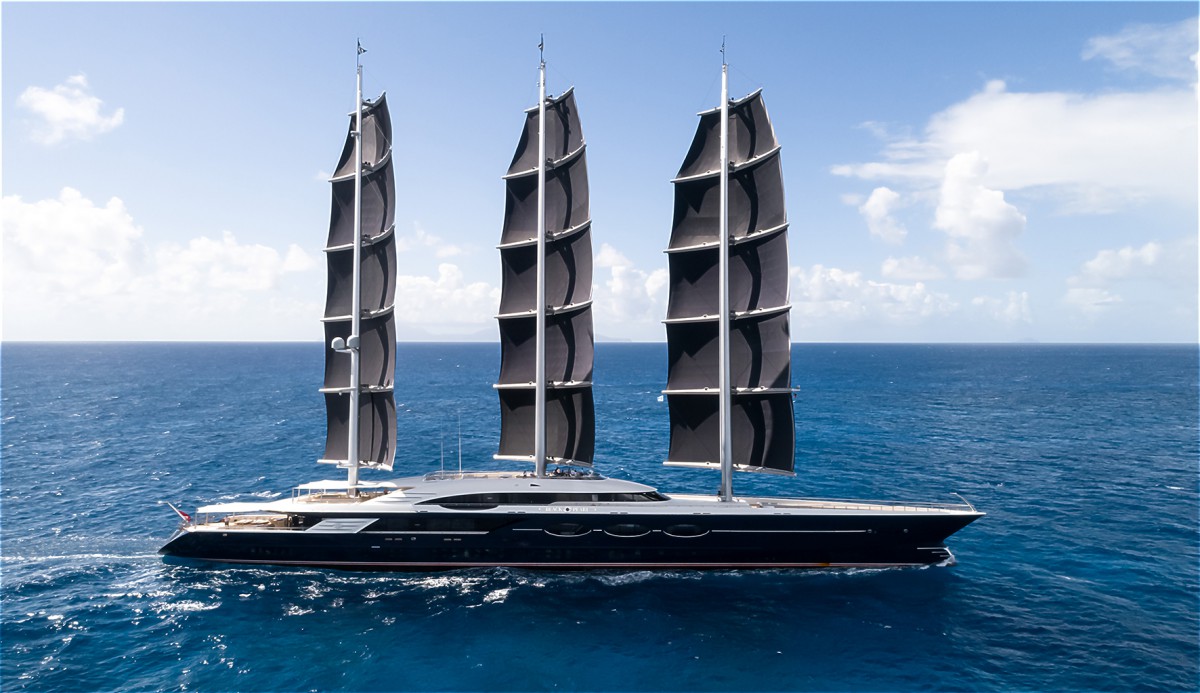
106.7-metre Black Pearl, built for Oleg Burlakov.
Munro was equally passionate when describing the yacht’s operational profile, something that may be of interest to many owners of very large motoryachts, explaining that Black Pearl’s operating budget, based on its sailing percentages and covering 60,000nm over its current life time, equates to an average of 6 per cent of the value per annum, perhaps less than half that of a similar sized motoryacht.
Over ten years of operation, this number is significant and, when combined with the sustainability and energy-efficiency credentials, is something for owners to seriously consider. The yacht is still owned
by the Burlakov family and is now offered for charter, so anyone can encounter this super-sailing masterpiece and feel good that their ocean footprint and consumption figures are seriously credible.
Finally, if you Google the words ‘Project Zero’, you find a plethora of projects and innovations that are all planet-focused in various industry sectors. However, perhaps one of the most exciting and sector-challenging projects in our industry also bears the name and is in an advanced stage of construction at Vitters shipyard in Holland. Much has been written on this project and everyone seems to be drooling at the idea of a sailing yacht without an engine, pushing the ultimate boundary and being truly ‘zero’ in its operational mode.
Very little is known about the owner, but having read much of the open-source content provided by Foundation Zero, the team challenged to make this project a reality, one can only assume a super-smart owner is sitting in the background pulling the strings and pushing the team. Even though the Project Zero website foundationzero.org mentions a group of investors, we anticipate that there may be one or two principals at the helm. The beauty of this project isn’t the fact that a zero-emission sailing yacht has been conceived and is now being built, but the commendable decision to make all the research and analysis open-source, so everyone can benefit and we can start to build really smart yachts in the future. In the case of Project Zero, the future is now.
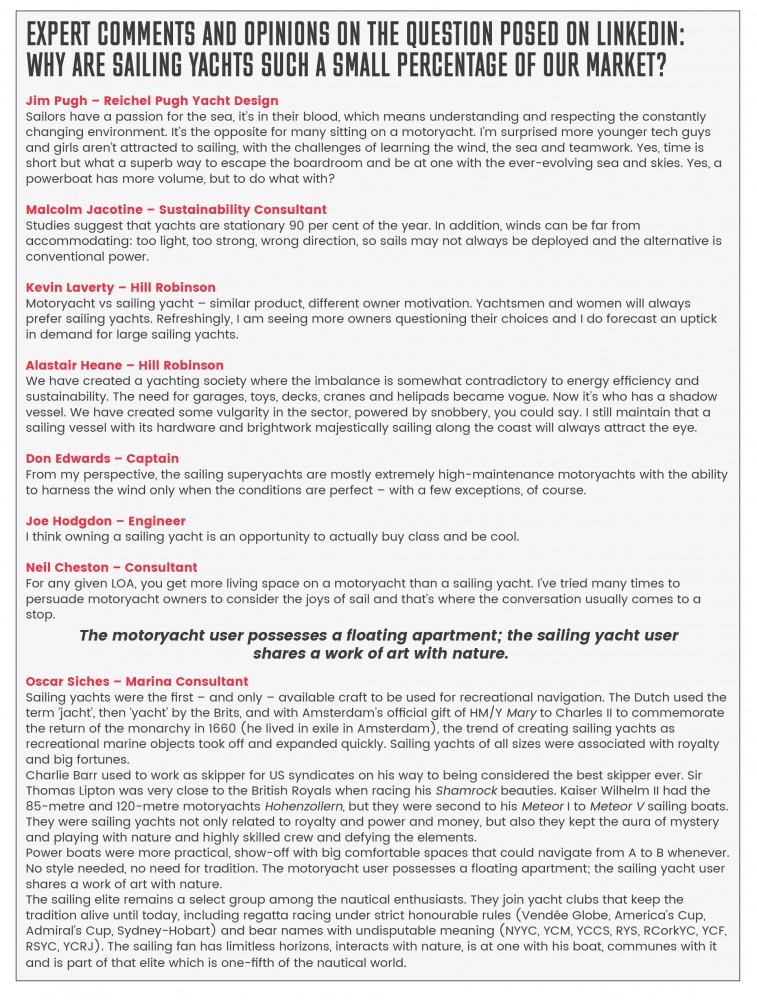
Summary
As a lifelong lover of sailing and admirer of the beauty and balance of sailing yachts, it’s clear that the vast majority of superyacht owners are focused on volume, real estate and value per GT. However, there are other parameters to consider when it comes to smart owners and the yachts they design, build and buy. It’s easy to see the factors that stimulate billionaires and UHNWIs to invest in sailing yachts, and it’s not all about racing or heeling or speed.
There is such pleasure of being at the helm under full sail in the Pacific, the emotion of converting the wind energy into performance and going where it takes you, the camaraderie of connecting with other owners at regattas or in remote anchorages, and, bizarrely, the uniquely positive feeling of other people from all walks of life appreciating the beauty and elegance of a stunning sailing yacht sitting in a marina or harbour.
Note the perception of and the relationship between people walking around a marina and the neuro responses to seeing a vast white superyacht with multiple decks towering over the landscape with a constant stream of exhaust puffing out of the stack versus a curvaceous sleek sailing yacht that has all the elegance and balance that the human eye immediately appreciates the camber, the sheer line and the tumble home. Even beasts like Black Pearl or the iconic Maltese Falcon draw crowds of admirers for their innovation and individuality. It would be hard for any eco-warrior protestor to consider a random attack on something so magnificent and intelligently built.
Are super-sized sailing yacht owners, the smartest owners? When they invest in visionary, sustainable projects, the answer is a resounding yes.
Profile links
NEW: Sign up for SuperyachtNewsweek!
Get the latest weekly news, in-depth reports, intelligence, and strategic insights, delivered directly from The Superyacht Group's editors and market analysts.
Stay at the forefront of the superyacht industry with SuperyachtNewsweek
Click here to become part of The Superyacht Group community, and join us in our mission to make this industry accessible to all, and prosperous for the long-term. We are offering access to the superyacht industry’s most comprehensive and longstanding archive of business-critical information, as well as a comprehensive, real-time superyacht fleet database, for just £10 per month, because we are One Industry with One Mission. Sign up here.
Related news
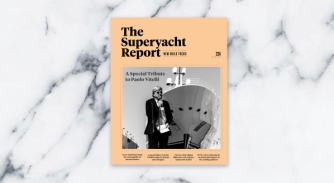
The Superyacht Report: New Build Focus 224 – Out Now
The first edition of The Superyacht Report in 2025 is now live and ready to read online, dissecting the topics that really matter to the new-build market
Crew

Building above and beyond
Oceanco’s yachts are iconic for a reason. But now the Dutch giant is pushing its shipbuilding abilities to new heights through its range of custom build s
Fleet
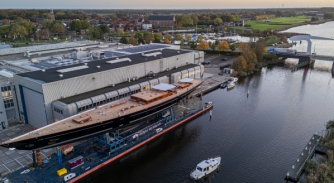
Aquarius II readies to launch
Royal Huisman is applying the final touches to its latest 65-metre ketch before it heads to its new owners
Fleet
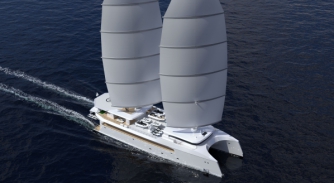
Construction begins on world’s largest sailing catamaran
Echo Yachts has embarked on an ambitious project to build a 57-metre multihull, drawing on expertise from sailing yacht design specialists
Fleet

Royal Huisman to build world’s tallest sloop
The Dutch custom yacht builder has announced the signing of an 81-metre sailing yacht: Noir
Fleet
Related news
The Superyacht Report: New Build Focus 224 – Out Now
2 months ago
Building above and beyond
4 months ago
Aquarius II readies to launch
6 months ago
Royal Huisman to build world’s tallest sloop
12 months ago
NEW: Sign up for
SuperyachtNewsweek!
Get the latest weekly news, in-depth reports, intelligence, and strategic insights, delivered directly from The Superyacht Group's editors and market analysts.
Stay at the forefront of the superyacht industry with SuperyachtNewsweek



